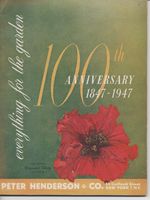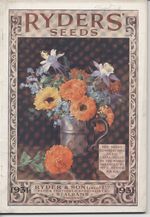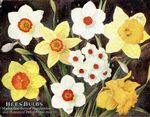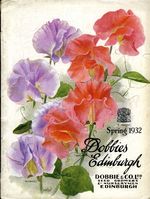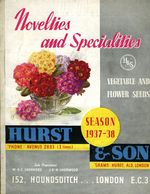
Sutton's Amateur's Guide in Horticulture and General Garden Seed Catalogue for 1921. (Click for more images)
The period from the 1880s to the First World War has been called the “Golden Age of Seed Catalogue Art”1 because of the colorful paintings and lithographs that were produced for covers. The OSU collection contains no examples; one can see them instead in the excellent digital collections of seed and nursery trade catalogues of the Smithsonian Institution and the National Agricultural Library. http://www.sil.si.edu/digitalcollections/SeedNurseryCatalogs/, http://www.nal.usda.gov/speccoll/seedcatalogimagegallery.shtml.
The best illustration of the evolution of colored cover art in the OSU collection is on the inside cover of the 1947 centenary catalogue of the Peter Henderson company. It shows the company’s catalogue covers from each decade from 1847 to 1937—a representative picture of changing fashions and available printing options.
Although many of the (mostly British) catalogues of the 1920s and 30s in the OSU collection are illustrated primarily with photographs, some companies commissioned color paintings for covers and interior plates. These paintings are in general, much more evocative of the romance and delicacy of flowers than photographs are. Many paintings are unsigned, but the OSU collection contains some notable examples by the botanical painters Beatrice Parsons and Winifred Walker. Parsons’ paintings of cottage gardens illustrated many books, as well as the cover of Sutton’s 1921 catalogue (scanned below). Walker was the official artist for the Royal Horticultural Society from 1929-1939 as well as the artist-in-residence at the University of California in 1943. She later wrote and illustrated the book All the Plants of the Bible in 1957. Walker produced both catalogue art and seed packet illustrations for several different companies. Her color paintings, some of which were exhibited at the Royal Academy, are reproduced in the 1925-1929 catalogues of the Ryder company, for which she also illustrated covers. Her work appears too, in the catalogues of Blackmore & Langdon, Maxwell & Beale, Bee’s, Toogood’s, and in the Peter Henderson centenary catalogue of 1947. Ryder sold prints of Walker’s paintings individually, and offered an album of some of them to customers who purchased more than one pound’s worth of seeds in 1931.
Another watercolor painter hired by several companies was M.A. West; in the OSU collection, her work figures in Dobbie’s catalogues from 1928-1932, and those of the carnation breeder James Douglas in 1932.
While color printing and photography had reached a high level of sophistication by the 1920s, many of the catalogues from the 1920s through the 1940s in OSU’s collection contain very little color, and many contain few or no illustrations--a reminder that not every company followed all the same trends at the same time. In the late 1930s, many companies produced assortments of images that other companies could use for their catalogues, seed packets or store displays. Examples include Bodger in 1936, with its selection of black and white electros, nickeltypes, transparencies and photographs, and Hurst & Son in 1937, with full color pictorial pockets and rotating display racks.

